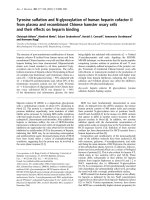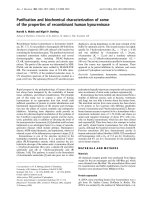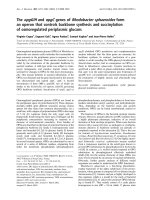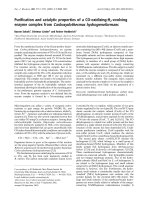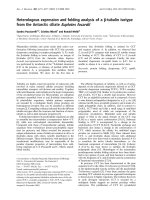Báo cáo y học: "A demographic and epidemiological study of a Mexican chiropractic college public clinic" ppsx
Bạn đang xem bản rút gọn của tài liệu. Xem và tải ngay bản đầy đủ của tài liệu tại đây (220.59 KB, 7 trang )
BioMed Central
Page 1 of 7
(page number not for citation purposes)
Chiropractic & Osteopathy
Open Access
Research
A demographic and epidemiological study of a Mexican chiropractic
college public clinic
Daniel A Martinez*, Ronald L Rupert and Harrison T Ndetan
Address: Parker College of Chiropractic Research Institute, Parker College of Chiropractic, 2500 Walnut Hill Lane, Dallas, TX 75229, USA
Email: Daniel A Martinez* - ; Ronald L Rupert - ; Harrison T Ndetan -
* Corresponding author
Abstract
Background: Descriptive studies of chiropractic patients are not new, several have been
performed in the U.S., Australia, Canada, and Europe. None have been performed in a Latin
American country. The purpose of this study is to describe the patients who visited a Mexican
chiropractic college public clinic with respect to demographics and clinical characteristics.
Methods: This study was reviewed and approved by the IRB of Parker College of Chiropractic and
the Universidad Estatal del Valle de Ecatepec (UNEVE). Five hundred patient files from the UNEVE
public clinic from May 2005 to May 2007 were selected from an approximate total number of 3,700.
Information was collected for demographics, chief complaints, associated complaints, and previous
care sought.
Results: The sample comprised 306 (61.2%) female. Most files (44.2%) were in the age range of
40–59 years (mean of 43.4 years). The most frequent complaints were lumbar pain (29.2%) and
extremity pain (28.0%), most commonly the knee. Most (62.0%) described their complaints as
greater than one year. Trauma (46.6%) was indicated as the initial cause. Mean VAS score was 6.26/
10 with 20% rated at 8/10.
Conclusion: Demographic results compared closer to studies conducted with private clinicians
(females within the ages of 40–59). The primary complaint and duration was similar to previous
studies (low back pain and chronic), except in this population the cause was usually initiated by
trauma. The most striking features were the higher number of extremity complaints and the
marked increased level of VAS score (20% rated as 8/10).
Background
Chiropractic has become increasingly utilized worldwide.
In the U.S. Chiropractic represents the third largest group
of health care providers after medical doctors and dentists
[1,2]. In the past, practitioners from other countries came
to the U.S. for training and then returned to their homes
to practice, sometimes contrary to the laws of their coun-
tries [3-8]. Presently, there are more than thirty-five chiro-
practic colleges and universities around the world where
native populations can now train for careers in chiroprac-
tic and other alternative health care professions in their
own countries [9,10]. Many of these schools are associ-
ated with outpatient teaching clinics and all utilize the
local population as a patient base. Mexico is a more recent
addition to this number, opening its school in August of
2001 and beginning classes with a small number of stu-
Published: 19 March 2009
Chiropractic & Osteopathy 2009, 17:4 doi:10.1186/1746-1340-17-4
Received: 13 August 2008
Accepted: 19 March 2009
This article is available from: />© 2009 Martinez et al; licensee BioMed Central Ltd.
This is an Open Access article distributed under the terms of the Creative Commons Attribution License ( />),
which permits unrestricted use, distribution, and reproduction in any medium, provided the original work is properly cited.
Chiropractic & Osteopathy 2009, 17:4 />Page 2 of 7
(page number not for citation purposes)
dents in September of that same year. The clinic opened
its doors to the public in 2005 when the beginning stu-
dents started their clinical experience [11]. With two years
of operation a research question can now be formulated
concerning the demographics and clinical characteristics
of the population seen in this clinic: Who are the people
utilizing this clinic and what are they seeking care for?
Descriptive studies of chiropractic patients are not new.
Recent and past studies describing patients demographics
and clinical characteristics of field clinicians have been
performed in the United States [12,13], Australia[14,15],
Canada[16,17], and Europe [18-20]. Other studies have
compared the patients at different chiropractic college
teaching clinics and those of private clinicians. Sawyer
and Stewart conducted a descriptive study of patients
attending a chiropractic teaching clinic in Minnesota in
1981–1982 [21]. Neyiendo and others have published
several descriptive and comparative studies describing
patients at a single teaching clinic, describing and compar-
ing patients at six chiropractic teaching clinics and a sub-
sequent study using these findings to compare with
patients attending private clinicians in the same area as
the teaching clinics [22-25]. Walsh and Jamison in 1992
compared patients at three teaching clinics with those of
three private clinics in Australia [26]. In 2003 Mor-
schhauser et. al conducted a descriptive cross-sectional
study comparing patients at on-campus clinics, off-cam-
pus clinics, and outreach clinics at four chiropractic col-
leges located in California, Illinois, Iowa, and Oregon
[27]. Stevens performed a demographic and referral anal-
ysis of a free clinic in the Buffalo, New York area in 2007
[28]. However, there is a dearth in literature; in fact none
have been identified, of related studies performed in a
Latin American country. Being that Mexico is a more
recent addition in this arena of health care, this would be
the first description of a pure source of a Spanish speaking
population.
The purpose of this study, thus, is to describe the patient
population who visited the Mexican chiropractic college
public clinic with respect to demographics and clinical
characteristics.
Methods
The respective Institutional Review Boards of Parker Col-
lege of Chiropractic and the Universidad Estatal del Valle
de Ecatepec (UNEVE) approved this study. This retrospec-
tive cross-sectional study used existing patient files for
data collection. The study was conducted at the UNEVE
chiropractic teaching clinic located on campus in a heavily
industrial suburb northeast of Mexico City. The clinic has
approximately 40 interns per year servicing the local pop-
ulation. Interns attend to patients for one year as part of
their clinical experience.
Five hundred patient files from May 2005 to May 2007
were selected at random from an approximate total
number of 3,700. Active files were stored in three 4 foot
high filing cabinets, with inactive files stored in 12 card-
board boxes with approximately 200 files per box. Boxes
were categorized according to year and sequence number.
Files were chosen if all forms were filled out completely
and all data could be ascertained. Every fifth file was to be
reviewed; however, since several from each box were not
filled out completely the random order was disrupted.
Consecutive files from each box were reviewed until 40
qualifying files were found to reach a total of 480. Active
files in cabinets up to May 2007 were similarly reviewed
to fill out the study goal of 500 files. Patient's identities
were protected by a unique identification code assigned to
each file. This code was privy to the investigators only.
Data for each patient was abstracted from a new patient
intake form. The eight-paged document included per-
sonal patient information, a systems review, a health sta-
tus questionnaire, an Oswestry and Roland Morris low
back questionnaire, a two-page physical exam form, and a
doctor's summary report. The health status questionnaire
was used by the interns to obtain most of the chief com-
plaint characteristics such as description and onset of the
complaint, quality and timing of pain complaints, Visual
Analog Scale information, what actions or situations
made the condition better or worse, other related symp-
toms, and if previous care was sought and if so what treat-
ment was provided. Patients completed these forms
themselves and/or were interviewed by the intern. The
Demographic information was abstracted from the
patient personal information, while the chief complaint
characteristics were abstracted primarily from the health
status questionnaire and doctor's summary report. A data
collecting form was created to collect information on
demographics (age, sex, marital status, and occupation),
chief complaints (nature, duration, cause, Visual Analog
Score (VAS), and associated complaints), and previous
care (physician previously attended/treatment plan). See
Additional file 1 and Additional file 2.
Data for this study was entered in an SPSS 15.0 (Chicago,
IL) spread sheet for analysis. Simple exploratory data anal-
ysis was performed to summarize percentages of demo-
graphic and chief complaint variables, and the mean and
standard deviation of duration and VAS were compared
with several variables.
Results
Demographics
Table 1 presents the frequency of demographic variables.
The sample comprised of 306 (61.2%) female. The mean
(standard deviation) of the patients' age was 43.4 (15.9)
years. Most (221, 44.2%) of the patients were between the
Chiropractic & Osteopathy 2009, 17:4 />Page 3 of 7
(page number not for citation purposes)
ages of 40 and 59 years. About 298 (59.6%) of them were
married, and 144 (28.8%) single; 134 (26.8%) performed
household work while 102 (24%) performed managerial
or clerical work (See Table 1).
Chief complaint
Table 2 presents frequency of the chief complaint varia-
bles. A secondary and tertiary complaint was included if
the patient reported more than one area of complaint.
Lumbar (29.2%) and extremities (28.0%) were the most
prevalent primary complaints. Secondary complaints
were lumbar (77/281, 27.4%) and extremities (48/281,
17.1%). Sacrum and coccyx (16/76, 21.1%), and extrem-
ities (19/76, 25.0%) were tertiary complaints. In total,
extremity complaints were recorded in 207 of the files
(41.4%), with 101 (48.8%) of these listed as knee com-
plaints.
Duration was calculated in days with a range of 1 day to
10,950 days (30 years). Chronic (75.6%) was assigned to
conditions greater than 90 days duration [29], with most
(62%) of these describing their complaints as greater than
one year. The mean duration of the chief complaint was
1,494.92 days (4.10 years), with the 40 to 59 age range
representing the highest number 178/500 (36%) of
chronic cases (Table 3). Trauma in 47.0% of cases was
indicated as the initial cause. The duration for causes due
to trauma was 1,603.49 days (6.32 years). The most com-
mon description of trauma was a slip and fall either to the
posterior or to the knees. Of the 207 extremity complaints
147 (29.4%) were greater than three months duration
with 55.8% (82/147) of these classified as knee com-
plaints. The most frequent primary complaint (lumbar)
Table 1: Frequency n(%) of the distribution of demographics
variables
Demographics Overall N(%)
Sample Total 500
Gender Male 194(38.8)
Female 306(61.2)
Age <20 Yrs 39(7.8)
20–39 Yrs 161(32.2)
40–59 Yrs 221(44.2)
>59 Yrs 79(15.8)
Marital Status Married 298 (59.6)
Single 144(28.8)
Divorced 11(2.2)
Widowed 30(6.0)
Civil Union 17(3.4)
Occupation Housework 134 (26.8)
Blue collar/manual 66(13.2)
Professional/office 120(24.0)
Student 57(11.4)
Shopkeeper 74(14.8)
Other 49(9.8)
Table 2: Frequency n(%) of the chief complaint variables
Primary Complaint N(%)
Head and Neck 82(16.4)
Thoracic 63(12.6)
Lumbar 146(29.2)
Pelvis 42(8.4)
Sacrum and coccyx 19(3.8)
Extremities 140(28.0)
Radiculopathy 2(.4)
Other 6(1.2)
Total 500(100)
Secondary Complaint
Head and Neck 15(5.3)
Thoracic 27(9.6)
Lumbar 77(27.4)
Pelvis 33(11.7)
Sacrum and coccyx 41(14.6)
Extremities 48(17.1)
Radiculopathy 35(12.5)
Other 5(1.8)
Total 281/500(56.2)
Tertiary Complaint
Head and Neck 2(2.6)
Thoracic 3(3.9)
Lumbar 13(17.1)
Pelvis 9(11.8)
Sacrum and coccyx 16(21.1)
Extremities 19(25.0)
Radiculopathy 13(17.1)
Other 1(1.3)
Total 76/500(15.2)
Extremity complaints* Total N(%) ≥90 days N(%)
Shoulder 50(24.2) 33(22.4)
Elbow 9(4.3) 4(2.7)
Hand 11(5.3) 8(5.4)
Hip 8(3.9) 4(2.7)
Knee 101(48.8) 82(55.8)
Ankle 28(13.5) 16(10.9)
Total 207/500
(41.4)
147/500
(29.0)
Duration of complaint N(%)
Acute (<90 days) 122(24.4)
Chronic (> = 90 days)
< 365 days 68(13.6)
365 days + 310(62)
Total 500(100)
Cause
Trauma 235(47.0)
Work Related 74(14.8)
Sports Related 68(13.6)
Idiopathic 98(19.6)
Other 25(5.0)
Total 500(100)
Chiropractic & Osteopathy 2009, 17:4 />Page 4 of 7
(page number not for citation purposes)
averaged 2,016.61 days (5.52 years) duration, while the
second most frequent complaint (extremities) averaged
976.08 days (2.67 years), with knee complaints averaging
1,633.68 days (4.48 years). The mean of the VAS was
6.26/10 (SD 2.0), with 20% classifying their pain as 8/10.
Mean VAS scores were above 6/10 in all categories above
20 years of age and above 5.5/10 in the under 20 year's age
group (Table 4). The mean VAS score when trauma was
listed as the cause was 6.4/10 (1.96). Of the two most
prevalent primary complaints, lumbar conditions VAS
scores were listed as 6.4/10 (1.98) and extremities as 6.2/
10 (2.14) with knee complaints 6.6/10 (2.23). "No previ-
ous attention" was listed in 43.2% of cases; however,
32.4% sought "Medical attention" first. Of these, drug
therapy was sought in 25.2% of cases. The corresponding
mean duration and VAS scores were1,225.77 days (3.36
years) and 5.8/10 (SD 1.99) for "No previous attention"
and 1,857.65 days (5.09 years) and 6.8/10 (SD1.94) for
"Medical attention" (Tables 5 and 6). About 46.6% did
not list a related symptom.
Discussion
There was a predominance of women (61.2%) in this
study, which is consistent with studies performed in other
countries [12-28]. However, this proportion is greater
than the proportion in the general population of the val-
ley of México which is 51.6% female [30]. The most dom-
inant age group of 40–59 years is consistent with prior
descriptive studies of patients seen by field doctors [12-
20], but this group is older than the dominant group in
studies comparing patients at teaching clinics [21-28]. It
is, however, consistent with the dominant age group of
patients seen in the teaching clinics where the population
was predominantly Hispanic [22,27].
The most frequent primary complaint of low back pain
(29.2%) compares with numerous other studies, how-
ever, the second most frequent primary complaint of
extremity pain (28.0%), most commonly the knee, is con-
siderably higher. This is nearly 2–4 times higher than field
studies performed in the United States [12,13], and
Europe [18-20], and almost twice that of Australian stud-
ies [15,26]. Nyiendo's study of six colleges in 1989 pro-
vides a closer comparison with a range of 17–22% among
the participating clinics [22]. The percentage of extremity
complaints is even higher when the secondary and tertiary
complaints are included (41.4%). This would seem to
coincide with the high percentage of causes due to trauma
Table 3: Mean of duration with chief complaint
Chief Complaint Mean Days(years) Standard deviation Days(years) N
Head and Neck 1561.99(4.28) 1875.67(5.14) 82
Thoracic 1435.11(3.39) 1679.27(4.60) 63
Lumbar 2016.61(5.52) 2643.98(7.24) 146
Pelvis 1453.57(3.98) 2308.61(6.3) 42
Sacrum and coccyx 1592.95(4.36) 2131.57(5.34) 19
Extremities 976.08(2.68) 1697.50(4.65) 140
Radiculopathy 165.00(0.45) 190.92(0.52) 2
Other 1040.83(2.85) 897.30(2.46) 6
Total 1494.92(4.10) 2128.81(5.83) 500
Visual Analog Scale
01(.2)
12(.4)
2 12(2.4)
3 31(6.2)
4 52(10.4)
5 97(19.4)
6 69(13.8)
7 70(14.0)
8100(20)
9 48(9.6)
10 18(3.6)
Total 500(100)
Related Symptoms
None 233(46.6)
Fever 7(1.4)
Night sweats 48(9.6)
Dizziness 87(17.4)
Blurred vision 64(12.8)
Fatigue 144(28.8)
Other 61(1.22)
Total 500(100)
Previous Attended
None 216(43.2)
Medical 162(32.4)
Physiotherapist 39(7.8)
Alternative health care 59(11.8)
Folk medicine 46(9.2)
Other 3(.6)
Total 500(100)
Treatment
None 215(43.0)
Drug therapy 126(25.2)
Surgery 2(.4)
Physiotherapy 52(10.6)
Other 150(30.0)
Total 500(100)
* Includes primary, secondary, and tertiary complaints
Table 2: Frequency n(%) of the chief complaint variables
Chiropractic & Osteopathy 2009, 17:4 />Page 5 of 7
(page number not for citation purposes)
(47.0%). All age groups reported more traumas than any
other cause in their respective groups.
It can be said that this population suffers from chronic
complaints. By far, the majority of patients had com-
plaints greater than three months, with a high percentage
of these greater than one year (Table 2). Other studies
have recorded similar chronic conditions [19,22,27], but
this population averaged over four years with their com-
plaints (Table 3). This may suggest that either patients
have chosen to live or have had to live with their condi-
tions or had sought other care without adequate results
before seeking chiropractic care. It is also possible, due to
the paucity of chiropractic clinics throughout the valley of
México that chiropractic care has just not been an availa-
ble option until recently.
According to Mersky, pain is defined as "an unpleasant
sensory and emotional experience" that is "always subjec-
tive." [31]. Pain perceptions rated high with this popula-
tion. Twenty percent of the total study population defined
their pain as an 8/10 on the VAS scale. Multiple compari-
sons among age groups only showed a significant differ-
ence between the <20 and >60 years age groups, even then
the <20 group listed a mean of greater than 5/10 on the
VAS (Table 4). Pain perception was still high even after
initial care; for example, mean VAS scores after medical
treatment was 6.8/10 (1.940) in 32% of cases (Table 6).
In accordance with a study performed by Nyiendo com-
paring patients at teaching colleges with field clinicians,
this compares more closely to the field clinicians than
with the teaching clinics [22]. This study was limited to
initial VAS scores and subsequent scores are not available
for comparison. Associated symptoms were listed on the
intake form for the patient to choose from. Despite 46.6%
listing no other symptoms, it was not always clear if the
patient who did list a symptom understood that it must
relate to the primary cause.
Even though the highest percentage of files listed no previ-
ous treatment, the question on the intake form could be
misleading. The question was stated as "Have you been
attended to previously for these health problems?" (¿Ha
sido atendido previamente por estos problemas de salud?).
It was not clear whether the patient attended their problem
immediately or if the patient treated themselves. Also, there
was some confusion with this question concerning alterna-
tive health care providers with some of the folk medicine
providers. Mexico has a strong tradition of folk healers, one
being a "huesero" (bonesetter) [32], who are sometimes
confused with chiropractors by the general public and it
was not always clear who was being indicated.
Certain limitations of this study are acknowledged. This
study was purely descriptive in nature and limited to
patient recall and responses or the interpretation of the
response by the intern and any attempt to verify the
patient response with clinical findings was limited by the
experience of the intern; therefore, the diagnostic catego-
ries used were very general. The randomization was weak-
ened due to the inconsistency of completeness of the files;
however, randomization may have been achieved if the
files were first excluded by the stated criteria and then ran-
domly selected. Some questions in the intake forms made
some categorization of previous care difficult. While the
sample size may have been representative of the clinic, it
may not be representative of all of Mexico.
Despite these limitations, it is possible to gain an insight
as to the patient population that attended the clinic. This
study provides a demographic and epidemiological foun-
dation for future investigation; however, recommenda-
tions for strengthening intake forms and policies of the
clinic may help to facilitate future desired data collection.
Practical applications of this study would allow practi-
tioners to better understand and prepare for the most
common conditions that may present in the clinic.
Table 5: Mean of duration with type of previous care
Type of previous care Mean Days(years) Standard deviation Days(years) N
None 1225.77(3.36) 1827.56(5.00) 216
Medical 1857.65(5.09) 2527.96(6.93) 160
Physiotherapy 1378.29(3.78) 1962.84(5.38) 31
Alternative 1842.44(5.05) 2123.65(5.82) 50
Folk Medicine 1236.68(3.39) 1900.58(5.21) 40
Other 385.00(1.06) 335.45(0.92) 3
Total 1494.92(4.10) 2128.81(5.83) 500
Table 4: Mean of visual analog scale with category of age
Age Range Mean Standard deviation N
< 20 years 5.54 1.833 39
20–39 years 6.31 1.966 161
40–59 years 6.20 2.031 221
> 60 years 6.65 2.063 79
Total 6.26 2.012 500
Chiropractic & Osteopathy 2009, 17:4 />Page 6 of 7
(page number not for citation purposes)
Conclusion
This study describes the profile of patients who visited a
Mexican chiropractic college public clinic with respect to
demographics and clinical characteristics. Demographic
results of mostly females within the ages of 40–59 are
more consistent with studies conducted with private clini-
cians rather than with studies conducted with teaching
clinics. The primary complaint and duration is similar to
both field and teaching clinic studies (low back pain and
chronic), except in this population the cause was usually
initiated by trauma (specifically falls). The most striking
features, however, were the higher number of extremities
complaint and the marked increased level of VAS score
(20% rated as 8/10). Future studies may explore the treat-
ment and prevention of knee complaints.
Competing interests
The authors declare that they have no competing interests.
Authors' contributions
DM contributed to the design, carried out the data collec-
tion, performed the literature search, and drafted and
wrote the manuscript. RR contributed to the supervision,
concept and design, and editing and revision for the intel-
lectual content of the article. HN provided statistical anal-
ysis of the data, and critical review of the manuscript. All
authors read and approved the final manuscript.
Additional material
Acknowledgements
The authors wish to thank the Universidad Estatal del Valle de Ecatepec for
all its administrative and professional support in the completion of this
project. We express our thanks to Enrique Montiel Flores, M.S. for his
advice during this project and to Dr. María de Jesús Moreno Moreno, M.E.,
Secretaria Técnica de la Comisión de Investigación of the UNEVE, for her
help in the completion of the UNEVE IRB forms. A special thanks to Domi-
ciano de Jesús Jiménez, D.C. for his help in the collection and review of the
data.
References
1. Shekelle PG: The Use and Costs of chiropractic Care in the
Health Insurance Experiment. Santa Monica. Calif: RAND;
1994.
2. Hurwitz EL, Coulter ID, Adams AH, Genovese BJ, Shekell PG: Use of
chiropractic services from 1985 through 1991 in the United
States and Canada. Am J Public Health 1998, 88:771-76.
3. Peters RE, Chance MA: Chiropractic in Australia: The first forty
years (1905–1945). Chiropr Hist 1996, 16(1):29-38.
4. Brantingham JW, Snyder WR: From Africa To Africa. Chirop Hist
1999, 19:53-9.
5. Gromala T, Oyelowo T: A historical overview of foreign stu-
dents in chiropractic: 1900–1988. Chiropr Hist 1990, 10(1):31-4.
6. Chapman-Smith DA: Legislative approaches to the regulation
of the chiropractic profession. Med Law 1997, 16:437-49.
7. Bolton SP: Making it legal 'down under': the struggle for rec-
ognition in Australia. Chiropr Hist 1986, 6:11-6.
8. Sutherland DC: Trial by fire: Canadian Royal Commissions
investigate chiropractic. Chiropr Hist 1985, 5:27-37.
9. World Congress of Chiropractic Students [s
worldwide.com/about.php]
10. Chiroweb Dynamic Chiropractic [ />college/]
11. Universidad Estatal del Valle de Ecatepec [http://
www.uneve.edu.mx/]
12. Coulter ID, Shekelle PG: Chiropractic in North America: a
descriptive analysis. J Manipulative Physiol Ther 2005, 28:83-9.
13. Mootz RD, Cherkin DC, Odegard CE, Eisenberg DM, Barassi JP,
Deyo RA: Characteristics of chiropractic practitioners,
patients, and encounters in Massachusetts and Arizona. J
Manipulative Physiol Ther 2005, 28:645-53.
14. Xue C, Zhang AL, Lin V, Meyers R, Polus B, Story DF: Acupuncture,
chiropractic, and osteopathy in Australia: a national popula-
tion survey. BMC Public Health 2008, 8:105.
15. Ebrall PA: A descriptive report on the case-mix within Aus-
tralian chiropractic practice. Chirop J Aust 1993, 23:92-97.
16. Hurwitz EL, Chiang L: A comparative analysis of chiropractic
and general practitioner patients in North America: findings
from the joint Canada/United states survey of health 2002–
03. BMC Health Service Research 2006, 6:49.
17. Aker P, Mior S, Hagino C: Utilization of chiropractic services in
Ontario, Canada [abstract]. J Manipulative Physiol Ther 1994,
17:272.
18. Pedersen P: A survey of chiropractic practice in Europe. Euro-
pean Journal of Chiropractic 1994, 42:3-28.
19. Rubinstein S, Pfeifle CE, van Tulder MW, Assendelft WJJ: Chiroprac-
tic patients in the Netherlands: A descriptive study. J Manip-
ulative Physiol Ther 2000, 23:557-63.
20. Hartvigsen J, Sorensen LP, Graesborg K, Grunnet-Nilsson N: Chiro-
practic patients in Denmark: A short description of basic
characteristics. J Manipulative Physiol Ther 2002, 25:162-67.
21. Sawyer CE, Stewart LA: Demographic, clinical, and utilization
characteristics of chiropractic teaching clinic patients: impli-
cations for clinical and epidemiological investigation. J chiro
1984, 18:58-66.
22. Nyiendo J, Phillips BR, Meeker WC, Konsler G, Jansen R, Menon M:
A comparison of patients and patient complaints at six chi-
ropractic college teaching clinics. J Manipulative Physiol Ther
1989, 12:79-85.
23. Nyiendo J: A comparison of low back pain profiles of chiro-
practic teaching clinic patients with patients attending pri-
vate clinicians. J Manipulative Physiol Ther 1990, 13:437-47.
24. Phillips RB, Mootz RD, Nyiendo J, Cooperstein R, Konsler J, Mennon
M: The description of low back pain patients of field practic-
Additional file 1
Data collecting form in Spanish. The collecting form was dived into cat-
egory, where the information could be found in the patient file, and space
to record the information.
Click here for file
[ />1340-17-4-S1.doc]
Additional file 2
English translation of collecting form. English translation of the collect-
ing form (Additional file 1).
Click here for file
[ />1340-17-4-S2.doc]
Table 6: Mean of visual analog scale with type of previous care
Type of previous care
None 5.80 1.999 216
Medical 6.83 1.940 160
Physiotherapy 6.48 2.365 31
Alternative 6.24 1.611 50
Folk Medicine 6.35 2.032 40
Other 5.33 1.155 3
Publish with BioMed Central and every
scientist can read your work free of charge
"BioMed Central will be the most significant development for
disseminating the results of biomedical research in our lifetime."
Sir Paul Nurse, Cancer Research UK
Your research papers will be:
available free of charge to the entire biomedical community
peer reviewed and published immediately upon acceptance
cited in PubMed and archived on PubMed Central
yours — you keep the copyright
Submit your manuscript here:
/>BioMedcentral
Chiropractic & Osteopathy 2009, 17:4 />Page 7 of 7
(page number not for citation purposes)
ing chiropractors contrasted with those treated in the clinics
of west coast chiropractic colleges. J Manipulative Physiol Ther
1992, 15:512-17.
25. Nyiendo J, Haldeman S: A critical study of the student interns'
practice activities in a chiropractic college teaching clinic. J
Manipulative Physiol Ther 1986, 9:197-207.
26. Walsh MJ, Jamison JR: A comparison of patients and patient
complaints at chiropractic teaching clinics and private clin-
ics. Chirop J Austr 1992, 22:87-91.
27. Morschhauser D, Long CR, Hawk C, Boulanger K, Black J, Carpenter
T, Iannelli G, Lynch OT, Stites J: Do chiropractic colleges' off-
campus clinical sites offer diverse opportunities for learning?
A preliminary study. J Manipulative Physiol Ther 2003, 26:70-6.
28. Stevens GL: Demographic and referral analysis of a free chiro-
practic clinic servicing ethnic minorities in the buffalo, NY
area. J Manipulative Physiol Ther 2007, 30:573-77.
29. U.S. National Center for Health Statistics [http://
www.cdc.gov/nchs/]
30. Instituto Nacional de Estadística, Geografía, e Informática
(INEGI) [ />]
31. Bolton JE, Wilkinson RC: Responsiveness of pain scales: a com-
parison of three pain intensity measures in chiropractic
patients. J Manipulative Physiol Ther 1998, 21:1-7.
32. Berenzon-Gorn S, Ito-Sugiyama E, Vargas-Guadarrama LA:
Enfermedades y padeceres por los que se recurre a terapeu-
tas tradicionales de la Ciudad de México. Salud publica de Méx-
ico 2006, 48:45-56.



